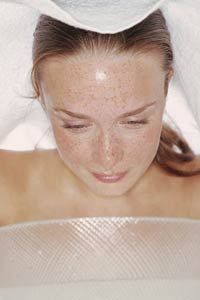In the never-ending pursuit of beauty, human beings have devised a number of skin care treatments. The ancient Greeks and Romans pioneered steam baths as a key part of their bathing regimen, with the belief that a good steam encouraged detoxification and promoted hydration and skin suppleness. Fortunately, today you don't have to build a Roman sudatorium in your backyard to get the benefits of a steam -- you can head to the spa instead.
Many estheticians favor steam cleanses as a way to soften and prepare your skin for treatments such as a facial mask. Exposure to the hot mist in a facial steam treatment overheats your skin and causes the blood vessels in your face to dilate. The ensuing rush of blood leaves you with a healthy-looking, pinkish glow. Your face will sweat copiously as your body seeks to cool itself, but as anyone who's sat in a sauna knows, a heavy sweat can leave you feeling pretty good.
Advertisement
But just like you shouldn't sit too long in the sauna, you also don't want to steam too much. An overdose of hot steam dries out your skin, which isn't what anyone looks for in a beauty treatment. If you have sensitive skin, you shouldn't steam more than once a month, and if you have eczema, you shouldn't be steaming at all. People with rosacea should stay away, too -- the dilated blood vessels caused by the steam can worsen the effects of the condition.
The benefits of facial steaming don't have much support from science, so choosing whether or not to steam is really up to you. If you trust your esthetician and steaming makes you feel and look better, go ahead and indulge.
What if you're a fan of facial steaming but not of paying spa prices? On the next page, we'll steam DIY-style.
Advertisement

